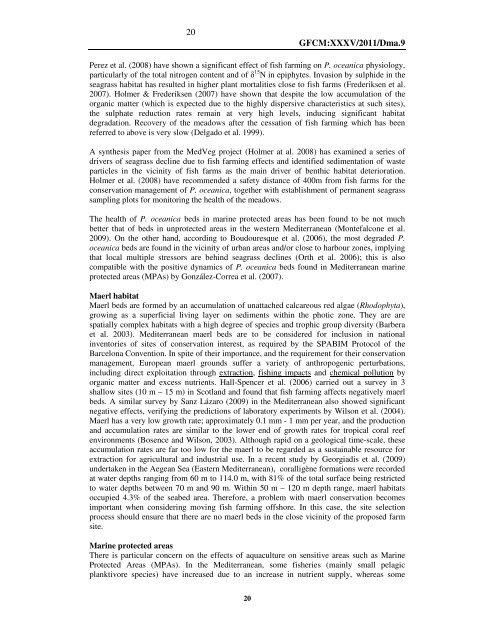Site selection and carrying capacity in Mediterranean ... - FAO Sipam
Site selection and carrying capacity in Mediterranean ... - FAO Sipam
Site selection and carrying capacity in Mediterranean ... - FAO Sipam
Create successful ePaper yourself
Turn your PDF publications into a flip-book with our unique Google optimized e-Paper software.
20<br />
20<br />
GFCM:XXXV/2011/Dma.9<br />
Perez et al. (2008) have shown a significant effect of fish farm<strong>in</strong>g on P. oceanica physiology,<br />
particularly of the total nitrogen content <strong>and</strong> of δ 15 N <strong>in</strong> epiphytes. Invasion by sulphide <strong>in</strong> the<br />
seagrass habitat has resulted <strong>in</strong> higher plant mortalities close to fish farms (Frederiksen et al.<br />
2007). Holmer & Frederiksen (2007) have shown that despite the low accumulation of the<br />
organic matter (which is expected due to the highly dispersive characteristics at such sites),<br />
the sulphate reduction rates rema<strong>in</strong> at very high levels, <strong>in</strong>duc<strong>in</strong>g significant habitat<br />
degradation. Recovery of the meadows after the cessation of fish farm<strong>in</strong>g which has been<br />
referred to above is very slow (Delgado et al. 1999).<br />
A synthesis paper from the MedVeg project (Holmer at al. 2008) has exam<strong>in</strong>ed a series of<br />
drivers of seagrass decl<strong>in</strong>e due to fish farm<strong>in</strong>g effects <strong>and</strong> identified sedimentation of waste<br />
particles <strong>in</strong> the vic<strong>in</strong>ity of fish farms as the ma<strong>in</strong> driver of benthic habitat deterioration.<br />
Holmer et al. (2008) have recommended a safety distance of 400m from fish farms for the<br />
conservation management of P. oceanica, together with establishment of permanent seagrass<br />
sampl<strong>in</strong>g plots for monitor<strong>in</strong>g the health of the meadows.<br />
The health of P. oceanica beds <strong>in</strong> mar<strong>in</strong>e protected areas has been found to be not much<br />
better that of beds <strong>in</strong> unprotected areas <strong>in</strong> the western <strong>Mediterranean</strong> (Montefalcone et al.<br />
2009). On the other h<strong>and</strong>, accord<strong>in</strong>g to Boudouresque et al. (2006), the most degraded P.<br />
oceanica beds are found <strong>in</strong> the vic<strong>in</strong>ity of urban areas <strong>and</strong>/or close to harbour zones, imply<strong>in</strong>g<br />
that local multiple stressors are beh<strong>in</strong>d seagrass decl<strong>in</strong>es (Orth et al. 2006); this is also<br />
compatible with the positive dynamics of P. oceanica beds found <strong>in</strong> <strong>Mediterranean</strong> mar<strong>in</strong>e<br />
protected areas (MPAs) by González-Correa et al. (2007).<br />
Maerl habitat<br />
Maerl beds are formed by an accumulation of unattached calcareous red algae (Rhodophyta),<br />
grow<strong>in</strong>g as a superficial liv<strong>in</strong>g layer on sediments with<strong>in</strong> the photic zone. They are are<br />
spatially complex habitats with a high degree of species <strong>and</strong> trophic group diversity (Barbera<br />
et al. 2003). <strong>Mediterranean</strong> maerl beds are to be considered for <strong>in</strong>clusion <strong>in</strong> national<br />
<strong>in</strong>ventories of sites of conservation <strong>in</strong>terest, as required by the SPABIM Protocol of the<br />
Barcelona Convention. In spite of their importance, <strong>and</strong> the requirement for their conservation<br />
management, European maerl grounds suffer a variety of anthropogenic perturbations,<br />
<strong>in</strong>clud<strong>in</strong>g direct exploitation through extraction, fish<strong>in</strong>g impacts <strong>and</strong> chemical pollution by<br />
organic matter <strong>and</strong> excess nutrients. Hall-Spencer et al. (2006) carried out a survey <strong>in</strong> 3<br />
shallow sites (10 m – 15 m) <strong>in</strong> Scotl<strong>and</strong> <strong>and</strong> found that fish farm<strong>in</strong>g affects negatively maerl<br />
beds. A similar survey by Sanz Lázaro (2009) <strong>in</strong> the <strong>Mediterranean</strong> also showed significant<br />
negative effects, verify<strong>in</strong>g the predictions of laboratory experiments by Wilson et al. (2004).<br />
Maerl has a very low growth rate; approximately 0.1 mm - 1 mm per year, <strong>and</strong> the production<br />
<strong>and</strong> accumulation rates are similar to the lower end of growth rates for tropical coral reef<br />
environments (Bosence <strong>and</strong> Wilson, 2003). Although rapid on a geological time-scale, these<br />
accumulation rates are far too low for the maerl to be regarded as a susta<strong>in</strong>able resource for<br />
extraction for agricultural <strong>and</strong> <strong>in</strong>dustrial use. In a recent study by Georgiadis et al. (2009)<br />
undertaken <strong>in</strong> the Aegean Sea (Eastern <strong>Mediterranean</strong>), coralligène formations were recorded<br />
at water depths rang<strong>in</strong>g from 60 m to 114.0 m, with 81% of the total surface be<strong>in</strong>g restricted<br />
to water depths between 70 m <strong>and</strong> 90 m. With<strong>in</strong> 50 m – 120 m depth range, maerl habitats<br />
occupied 4.3% of the seabed area. Therefore, a problem with maerl conservation becomes<br />
important when consider<strong>in</strong>g mov<strong>in</strong>g fish farm<strong>in</strong>g offshore. In this case, the site <strong>selection</strong><br />
process should ensure that there are no maerl beds <strong>in</strong> the close vic<strong>in</strong>ity of the proposed farm<br />
site.<br />
Mar<strong>in</strong>e protected areas<br />
There is particular concern on the effects of aquaculture on sensitive areas such as Mar<strong>in</strong>e<br />
Protected Areas (MPAs). In the <strong>Mediterranean</strong>, some fisheries (ma<strong>in</strong>ly small pelagic<br />
planktivore species) have <strong>in</strong>creased due to an <strong>in</strong>crease <strong>in</strong> nutrient supply, whereas some
















